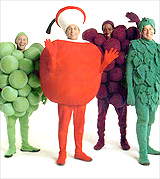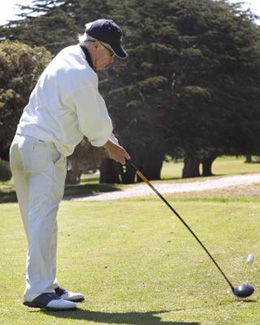Monterey Herald Newspaper Article
Stroke illuminates writer's purpose
Man spreads message
of recovery
By Dennis Taylor | Herald Staff Writer
Posted: 05/17/2010 01:29:54 AM PDT. Updated: 05/17/2010 09:03:19 AM PDT
 He understands on a cerebral level that his guilt isn't rational, but Dick Burns says he can't forgive himself for the massive hemorrhagic stroke he suffered more than four decades ago, when he was just 38 years old. He understands on a cerebral level that his guilt isn't rational, but Dick Burns says he can't forgive himself for the massive hemorrhagic stroke he suffered more than four decades ago, when he was just 38 years old.
"He won't let me off the hook," Burns says with a laugh, referring to The Almighty. "People don't live from a cerebral hemorrhage like the one I had, but I did. Now, I have a job to do."
His job, he says, is to provide hope and guidance to the 35 million Americans who are living with a serious illness—heart problems, cancer, the effects of a stroke, or any other debilitating condition—a quest that inspired him to write "Live Or Die: A Stroke of Good Luck."
The 160-page book is a how-to manual, "a roadmap," he says, designed to help people through all of the things he battled during his lifelong recovery process: pain, depression, despair, distress.
"Getting well is like climbing a ladder," he says. "You take it one step at a time, and as you move up the ladder, with your hands grasping, you move faster because you find out it works. This is the way with life."
Burns was a high-powered New York City advertising executive in a tailored, three-piece suit in the mid-1960s, designing campaigns for the Philadelphia-Reading Corp., a multi-faceted operation that included the Reading Railroad, and companies that made steel, boots, clothing and toys.

He dressed grown men in fruit costumes to sell Fruit of the Loom" underwear on Advertisement TV.
He hyped an airline by painting smiles on its planes.
He created ads for the hottest toys of the day: Baby Boo, Penny Brite, Suzy Cute, Johnny Seven and Secret Sam.
He worked hard and partied hard.
He also was a married father of three.
"I had a great life. I was making good money and living pretty high on the hog in those days," he remembers. "I probably was drinking a little too much, smoking a little too much, eating the wrong things. I was a nice enough guy, but I was a bit self-absorbed. My family came second in those days, when they should have come first."
In 1968, he moved his family to Orinda, where everything came tumbling down on a December day.
"I don't remember, because I was only 6 years old at the time, but I'm told I was the one who found my dad," says Rich Burns, Dick's 48-year-old son, who teaches and coaches high school football in Santa Rosa. "I seem to have this vague memory of flying down the stairs to tell my mom that something was wrong."
Wife sees signs
Dick's wife, Nancy, had just read an article about strokes and immediately recognized the symptoms. When paramedics showed up from a nearby fire station, she told them exactly what was happening and what needed to be done.
"It was congenital. A mass in the back of my brain burst, filled my head with blood and basically destroyed my brain," Burns says. "The doctors told my wife, 'His brain is dead. Make him comfortable and start making the arrangements.'"
Nancy wrote an obituary, which appears on the first page of his book, that was scheduled to appear in newspapers on Dec. 26, 1968, but Dick defied all predictions by showing improvement on a daily basis.
"The improvement is what kept anybody from pulling the plug on me, although there were a couple of times when I thought about pulling the plug on myself," he said. "I'm not really a religious man, but I am spiritual, and He came to visit me a few times. He gave me the poop. At one point, when I was ready to quit, He came and said, 'You've come this far ... don't screw it up.'"
Hard years—lots of them—were ahead, beginning with a letter that arrived quickly from Burns' business partners, terminating their relationship. Suddenly, the family had no means of support, a situation that sent Nancy back to work in the coming years as a teacher, a caterer and a secretary. Burns says she even did janitorial work.
 He spent part of 1969 and 1970 in four different hospitals. It was more than a year before he was able to talk again. He crawled for two years, then finally graduated to walking with a cane. He spent part of 1969 and 1970 in four different hospitals. It was more than a year before he was able to talk again. He crawled for two years, then finally graduated to walking with a cane.
"I was with him the first time he tried to drive a car again," said his daughter Lisa, 52, who survived that experience to graduate from Stanford and work in the aerospace industry. "I was not a religious child, but I remember suddenly becoming very, very religious, praying, 'Dear God, I promise to never, ever beat up my brother again if you get me home in one piece.'"
Tough love
Two years into his rehabilitation, Dick was hobbling beside a reservoir near their home when Nancy snatched the cane from his hand, broke it over her leg and said, "God gave you two legs. Now walk!"
"And I walked," he said. "It's called tough love. She was a very strong pillar of support, and without that support, I'm not sure what I would have done."
Pain, depression, stress and frustration turned Dick Burns into an impatient man and a snappish father. Lisa recalls a memorable meltdown one day when Shelley (now 50 and working for the government in Washington D.C.) and Rich were dumping too much sugar on their cereal.
"Dad just lost it, but Mom was amazing," she said. "She had a secret signal—a little wink she'd give us that meant, 'OK, he's being a jerk ... just go with it.' That would keep us calm, and then she'd take him somewhere and read him the riot act."
He had lost motor skills, but, oddly, little of his strength, a combination that caused him to break things. He'd pull the knobs off the window cranks in the car. He'd bust the keys on his typewriter. He'd knock the toilet paper off its holder. Says Lisa, "He'd be in the bathroom and we'd hear bounce, bounce, bounce ... 'Damn!'"
It was the late 1970s before Burns was well enough to work. He found a job with the world's largest consulting firm, George S. May, teaching companies how to maximize their advertising. Later, he formed his own consulting firm.
"I'd always begin with an apology for my slurred speech," he said. "I'd claim I had a cold, or I'd say I had burned my mouth that morning with hot coffee."
By then, Dick and Nancy had moved the cash-strapped family to the affluent city of Piedmont. Lisa says she always felt like the poor kid in town, but the schools there were outstanding, probably the reason she eventually got into Stanford, she said.
Their father's lifelong struggle, which included lung cancer, bleeding ulcers and back surgery, taught the whole family perseverance and an appreciation for life, Rich and Lisa agree.
Burns emerged as an upbeat, optimistic person who became a tower of strength Nancy, to whom he was married for 53 years before she died of lung cancer two years ago.
He has an active life
Conventional medical theory is that dead brain cells don't regenerate. Burns insists he's living proof that it isn't true. He said a growing number of doctors are beginning to believe him.
 Nowadays he eats well, exercises daily, plays golf once a week (his index is 21.4), and runs a 150-man group called Sons In Retirement, which meets regularly for golf, bridge, tennis and camaraderie. He marshals at the AT&T Pebble Beach National Pro-Am and will be on the course next month for the U.S. Open. Nowadays he eats well, exercises daily, plays golf once a week (his index is 21.4), and runs a 150-man group called Sons In Retirement, which meets regularly for golf, bridge, tennis and camaraderie. He marshals at the AT&T Pebble Beach National Pro-Am and will be on the course next month for the U.S. Open.
The book, though, has enriched his life by providing him with a genuine sense of purpose, as well as a perspective for his long struggle.
"It teaches people how to deal with it all," he said. "If I'd had this book after my stroke, along with today's medical advancement, my recovery would have been a matter of months, not years."
"A woman in a wheelchair met him at a book signing at Stanford," Lisa said. "The next day, she sent him an e-mail saying she'd read his book overnight and said his book had totally changed her attitude. The fact that he's touched at least one life means so much to him."
-----
|
 BUY THE BOOK
BUY THE BOOK
 FACEBOOK ME
FACEBOOK ME
 MY BLOGS
MY BLOGS
 He understands on a cerebral level that his guilt isn't rational, but Dick Burns says he can't forgive himself for the massive hemorrhagic stroke he suffered more than four decades ago, when he was just 38 years old.
He understands on a cerebral level that his guilt isn't rational, but Dick Burns says he can't forgive himself for the massive hemorrhagic stroke he suffered more than four decades ago, when he was just 38 years old.

 He spent part of 1969 and 1970 in four different hospitals. It was more than a year before he was able to talk again. He crawled for two years, then finally graduated to walking with a cane.
He spent part of 1969 and 1970 in four different hospitals. It was more than a year before he was able to talk again. He crawled for two years, then finally graduated to walking with a cane.
 Nowadays he eats well, exercises daily, plays golf once a week (his index is 21.4), and runs a 150-man group called Sons In Retirement, which meets regularly for golf, bridge, tennis and camaraderie. He marshals at the AT&T Pebble Beach National Pro-Am and will be on the course next month for the U.S. Open.
Nowadays he eats well, exercises daily, plays golf once a week (his index is 21.4), and runs a 150-man group called Sons In Retirement, which meets regularly for golf, bridge, tennis and camaraderie. He marshals at the AT&T Pebble Beach National Pro-Am and will be on the course next month for the U.S. Open.